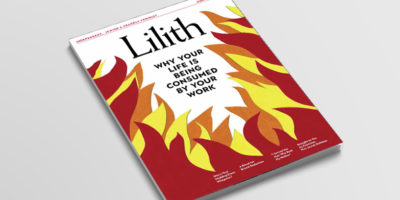
Reason, Desire, and a Deep Dive into Jewish History
One frustrating aspect of modern American culture—and its greatest divergence from Jewish culture—is its obsession with novelty, to the point of dismissing anything older than yesterday as worthless. The Weight of Ink (Haughton Mifflin Harcourt, $28), as its title suggests, is a counterweight to the world of Twitter: a story of words on paper and their uncanny endurance. This novel, by the immensely talented Rachel Kadish, is also a beautifully written meditation on reason and desire, a deep dive into Jewish history, and a riveting story whose weight stays with you.
Like A.S. Byatt’s Possession, The Weight of Ink’s plot hinges on a fantastic trove of manuscripts and the ego battles between scholars fighting over it. Helen Watt, a senior scholar recently diagnosed with Parkinson’s, learns of a stash of 17th century Portuguese and Hebrew letters in an old London home. The documents trace to London’s Sephardic Jews, a community traumatized by the Inquisition. Helen’s tremors force her to hire Aaron Levy, an insecure graduate student who resents Helen’s imperiousness, which he attributes to her non-Jewish appropriation of Jewish history. In fact Helen is scarred by a romance in 1950s Israel; Aaron likewise pines for a girl who abandoned him to make aliyah. Tensions between them initially turn The Weight of Ink into a novel of academic manners. But that’s not what Kadish is after.
When Aaron and Helen discover that the documents were produced by a rabbi’s female scribe, the book brings us into the life of Ester, a Portuguese Jewish orphan in 17th century London who becomes the ward and then the scribe of a rabbi blinded decades earlier by the Inquisition’s torturers. A talented scholar, Ester at 21 quickly realizes that as the rabbi ails, she will either have to marry or become a housemaid— in either case cut off from scholarship. But when a chaperoning job takes her to the Globe Theater, she is inspired to take on a new identity, disguising herself on paper as a man and writing to the great minds of her era— who then actually respond.
This launches the book into its real subject, which is less the content of 17th century thought (brace yourself for a primer on Spinoza’s pantheism) than the divide between the life of the mind and life as it’s actually lived. This may seem like an abstract topic, but it isn’t. For women, whose lives even today are often limited by mundane obligations, the gap between idealized beliefs and lived realities can be enormous. And for Jews, this gap is likewise more than theoretical. The Torah presumes we live in an imperfect world. Moreover, Jews in every era, including our own, have often been called upon to denounce their ancient allegiances, forcing many to compromise their beliefs or to choose between acceptance and integrity. As the book’s rabbi says, “The distances between things are vast”—referring to the physical space he blindly navigates, the social space between people, and the spiritual space left by God’s apparent absence.
If this sounds dense for a novel, it’s not. In The Weight of Ink, questions about God and reason find expression in Ester’s writings, but more often, Kadish dramatizes them through Ester’s experiences as a woman and a Jew, driven by a desire in both mind and body that her world forbids her. The choice between safety and integrity animates Ester’s every move—and she makes a lot of moves, intellectually and otherwise. As her interactions with non-Jews take on unexpected importance, she’s also forced to face the legacy of the Inquisition, which her community survived only by publicly denouncing themselves, leaving their children uncomfortable in their own bodies. For a book mostly set in a plague-ridden 17th century, it all feels weirdly familiar, a disturbing reminder of how much of our ancestors’ humiliations still live within us.
The book is not flawless. Kadish has the unenviable job of introducing an unfamiliar history; she mostly handles this with a light touch, but a few scenes read like Wikipedia entries. Likewise, connections involving major figures like Spinoza and Shakespeare can feel contrived on the page, as do several soapy plot twists that strain credibility.
These weaknesses would hardly be noticeable except that they are inconsistent with the rest of the book, which is rendered with the confidence of a master artist. Kadish writes with an incredible eye for the subtleties of emotion, and with countless gems of insight connected to the novel’s deeper themes. Here is Ester, for instance, contemplating her future: “[A]s she lay in the dark, a thought might rise murky out of the fatigue, and—she couldn’t help herself— she’d hold it tender as a newborn lest it slip from her hands, caressing it, trying to shield it against oblivion.” Here is Helen, contemplating hers: “She had seen early in life that there was none in this world to audit one’s soul… And if there was no auditor, one must audit one’s own soul, tenaciously and without mercy.”
Lines like these, thick with meaning and beauty, appear on every page. The intertwining of meaning and beauty in this novel at times feels too perfect, the balance between past and present storylines too idealized. Yet it’s a testament to Kadish’s talent that the novel’s ending, which ought to feel too neat, is immensely satisfying, a renewal of faith for characters and readers alike. Words on paper or screens only rarely last, but stories like Ester’s endure.
Dara Horn is a scholar of Yiddish and Hebrew literature and the author of five novels: In the Image, The World to Come, All Other Nights, A Guide for the Perplexed, and the forthcoming Eternal Life (January 2018).


